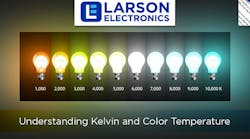When referencing color temperature, Kelvin (K) refers to a light source’s warmth or coolness. It is a unit of measurement used to describe the hue or color appearance of a given light source such as a lightbulb or the sun. The technical term of color temperature expressed in Kelvins is correlated color temperance (CCT).
The color range used in the lighting industry spans from 8,000 Kelvin, or 8,000K, to 2,000K with 5,000K being the most common. On this scale, the higher the Kelvin value a light source has, the ‘cooler’ the light looks visibly and has a color temperature closer to actual sunlight.
A ‘cool’ light has a white or blue hue and a color temperature between 4,100K and 6,500K, which falls on the higher end of the Kelvin scale and includes actual sunlight. Anything that falls above this range will emit light in deeper shades of blue and can exceed the color temperature of sunlight.
Lights in this range also have shorter wavelengths and are ideal for use in commercial or industrial settings such as parking garages, warehouses, gyms, sports fields, outdoor pole lighting and gas stations. Types of lighting used in these environments include fluorescent, LED or induction lighting with a color temperature of 5,000K or higher, which has the same or higher color temperature as the sun. Specific examples include typical LED office lights with a color temperature of 4,100K, industrial LED lights with a color temperature of 5,000K and actual sunlight with a color temperature of 5,780K.
Lights that fall in the middle of the Kelvin scale, between 3,500K and 4,100K, will have a more neutral, white hue that is similar to mid-day light. These lights have mid-range wavelengths and are ideal for use in office and retail spaces. Specific examples include halogen lightbulbs with a color temperature of 3,200K and compact fluorescent lamps (CFLs) with a color temperature of 4,000K.
A ‘warm’ light has an amber, reddish, orange or soft white to yellow hue and a color temperature of 2,000K to 3,000K, which falls on the low end of the Kelvin scale. This type of light has longer wavelengths and lightbulbs in this range are typically used in bathrooms and kitchens. One example of this type of light is an incandescent lightbulb with a color temperature of 2,700K.










